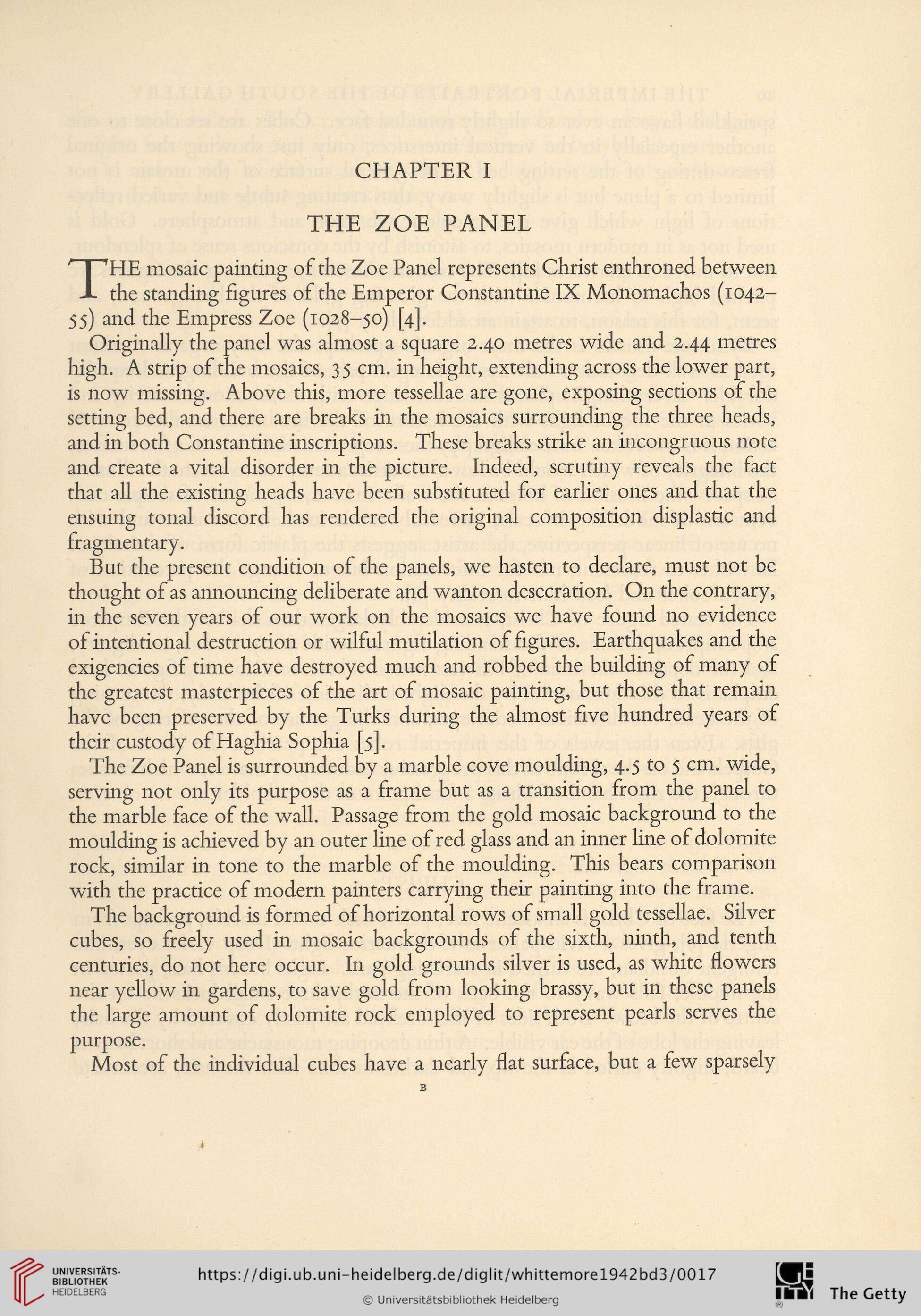CHAPTER I
THE ZOE PANEL
I "'HE mosaic painting of the Zoe Panel represents Christ enthroned between
the standing figures of the Emperor Constantine IX Monomachos (1042-
55) and the Empress Zoe (1028-50) [4].
Originally the panel was almost a square 2.40 metres wide and 2.44 metres
high. A strip of the mosaics, 3 5 cm. in height, extending across the lower part,
is now missing. Above this, more tessellae are gone, exposing sections of the
setting bed, and there are breaks in the mosaics surrounding the three heads,
and in both Constantine inscriptions. These breaks strike an incongruous note
and create a vital disorder in the picture. Indeed, scrutiny reveals the fact
that all the existing heads have been substituted for earlier ones and that the
ensuing tonal discord has rendered the original composition displastic and
fragmentary.
But the present condition of the panels, we hasten to declare, must not be
thought of as announcing deliberate and wanton desecration. On the contrary,
in the seven years of our work on the mosaics we have found no evidence
of intentional destruction or wilful mutilation of figures. Earthquakes and the
exigencies of time have destroyed much and robbed the building of many of
the greatest masterpieces of the art of mosaic painting, but those that remain
have been preserved by the Turks during the almost five hundred years of
their custody of Haghia Sophia [5].
The Zoe Panel is surrounded by a marble cove moulding, 4.5 to 5 cm. wide,
serving not only its purpose as a frame but as a transition from the panel to
the marble face of the wall. Passage from the gold mosaic background to the
moulding is achieved by an outer line of red glass and an inner line of dolomite
rock, similar in tone to the marble of the moulding. This bears comparison
with the practice of modern painters carrying their painting into the frame.
The background is formed of horizontal rows of small gold tessellae. Silver
cubes, so freely used in mosaic backgrounds of the sixth, ninth, and tenth
centuries, do not here occur. In gold grounds silver is used, as white flowers
near yellow in gardens, to save gold from looking brassy, but in these panels
the large amount of dolomite rock employed to represent pearls serves the
purpose.
Most of the individual cubes have a nearly flat surface, but a few sparsely
THE ZOE PANEL
I "'HE mosaic painting of the Zoe Panel represents Christ enthroned between
the standing figures of the Emperor Constantine IX Monomachos (1042-
55) and the Empress Zoe (1028-50) [4].
Originally the panel was almost a square 2.40 metres wide and 2.44 metres
high. A strip of the mosaics, 3 5 cm. in height, extending across the lower part,
is now missing. Above this, more tessellae are gone, exposing sections of the
setting bed, and there are breaks in the mosaics surrounding the three heads,
and in both Constantine inscriptions. These breaks strike an incongruous note
and create a vital disorder in the picture. Indeed, scrutiny reveals the fact
that all the existing heads have been substituted for earlier ones and that the
ensuing tonal discord has rendered the original composition displastic and
fragmentary.
But the present condition of the panels, we hasten to declare, must not be
thought of as announcing deliberate and wanton desecration. On the contrary,
in the seven years of our work on the mosaics we have found no evidence
of intentional destruction or wilful mutilation of figures. Earthquakes and the
exigencies of time have destroyed much and robbed the building of many of
the greatest masterpieces of the art of mosaic painting, but those that remain
have been preserved by the Turks during the almost five hundred years of
their custody of Haghia Sophia [5].
The Zoe Panel is surrounded by a marble cove moulding, 4.5 to 5 cm. wide,
serving not only its purpose as a frame but as a transition from the panel to
the marble face of the wall. Passage from the gold mosaic background to the
moulding is achieved by an outer line of red glass and an inner line of dolomite
rock, similar in tone to the marble of the moulding. This bears comparison
with the practice of modern painters carrying their painting into the frame.
The background is formed of horizontal rows of small gold tessellae. Silver
cubes, so freely used in mosaic backgrounds of the sixth, ninth, and tenth
centuries, do not here occur. In gold grounds silver is used, as white flowers
near yellow in gardens, to save gold from looking brassy, but in these panels
the large amount of dolomite rock employed to represent pearls serves the
purpose.
Most of the individual cubes have a nearly flat surface, but a few sparsely




